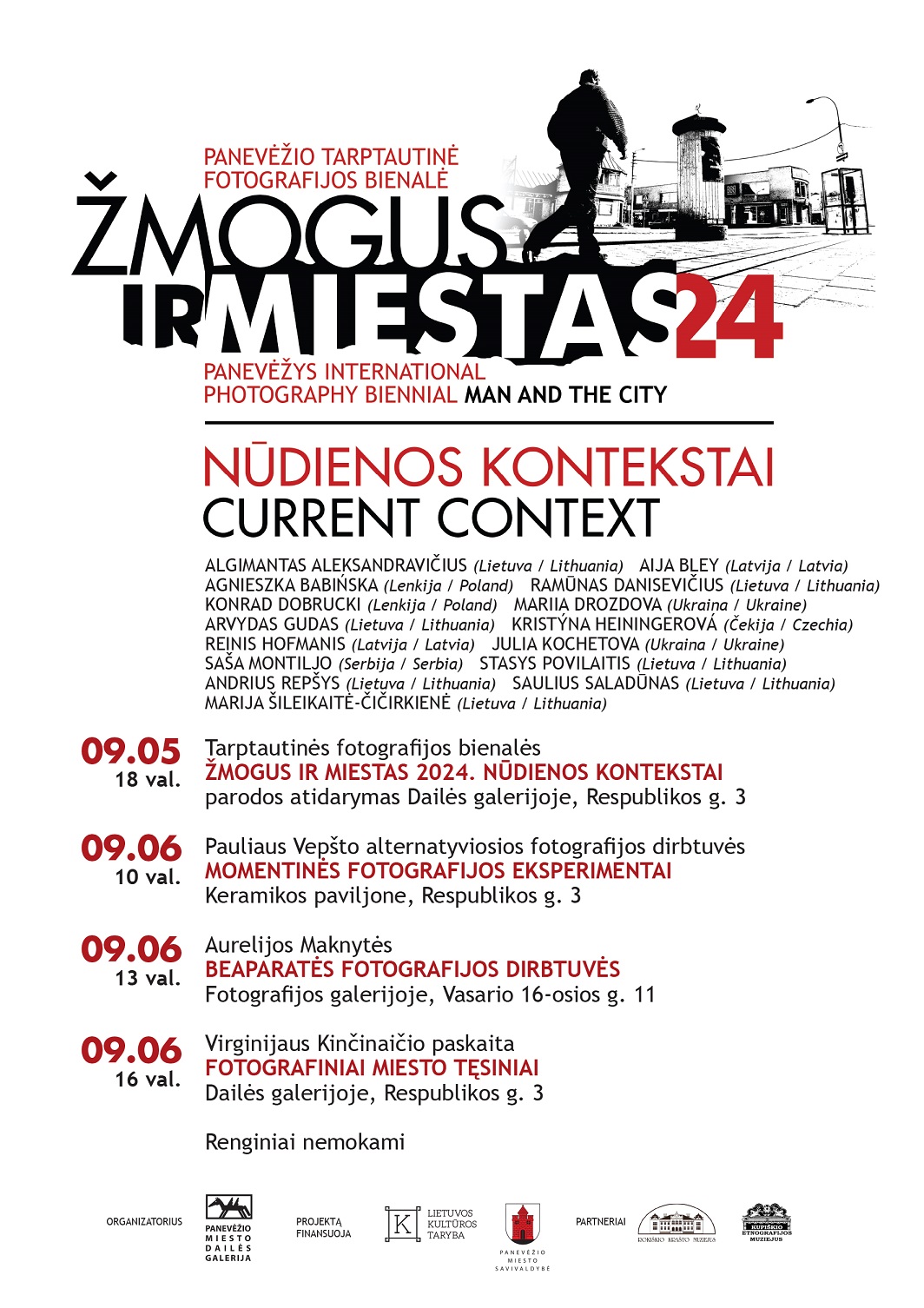2024 09 05 – 10 06
Opening September 5, 6 p.m.
Exhibited at Art Gallery (Respublikos str. 3, Panevėžys)
The photography project “Man and City”, which has been ongoing since 2005, is being updated this year with a specific sub-topic “Current Context”. The works of the participants in the project’s exhibition reveals that in the contemporary city, the dramas that have accompanied humanity for centuries continue in modern forms, and the enduring hopes of the past are still preserved. The photographers present today’s interpretations of timeless themes through a wide variety of works that reflect the entire spectrum of contemporary photography: from inexpressive typological photography to experiments with decorative forms and from photomontages to the candid capture of street life.
The photographs of Marija Šileikaitė-Čičirkienė, a photographer from Panevėžys, symbolically remind us of the primordial city, created by people, who drew the boundary between wild nature and civilization. On the one side of the city wall, we can see nature and chaos, and on the other side of the city wall, there is culture and controlled nature, which are impoverished and disappearing in the modern urban environment. Ramūnas Danisevičius, the well-known press photographer, interprets this relationship between human and nature, marked by struggle and symbiosis, with his characteristic subtle humour. This is conveyed in his photograph by juxtaposing different aspects and events of city life at a decisive moment.
However, the city is not just a defined area. It is also the communities of people, who live within it, which are sometimes brought together by unfavourable and dramatic circumstances. An example of this is the orphaned Ukrainian children living in a shelter, captured by Polish photographer Agnieszka Babińska. Meanwhile, the personal and dramatic works of Ukrainian photographer Julia Kochetova, show that today, just like in ancient cities, its citizens have to defend and survive war together.
Surviving means not only staying alive, but also preserving one’s identity, memory, and hope that the city and the culture it embodies will endure beyond any single individual. The works of Mariia Drozdova, another Ukrainian photographer, and Konrad Dobrucki, the Polish photographer, who immortalized the covered sculptures protected from the war in Ukrainian cities, remind us of this. The emphatically non-expressive form of the Polish author’s photographs highlights the symbolic significance of the sculptures themselves and the attempt to protect them. Meanwhile, Andrius Repšys, the Lithuanian photographer, also limiting his gaze, always looking straight from top to bottom, shows how ordinary city life flows around the sculptures in times of peace, when the symbolic meanings of the sculptures seem to dissolve in everyday life. Kristýna Heiningerová develops the same topic of the symbolic marking of the city in a series of photomontages, demonstrating that preserving memory sometimes requires a “fight” against the commercial development of the city.
Photographers Saulius Saladūnas, Stasys Povilaitis, and Arvydas Gudas from Panevėžys capture the everyday city in a documentary and reportage manner. However, there is no shortage of symbolic signs in everyday life. In the photographs of Saulius Saladūnas, city spaces are marked by graffiti and so-called tags, while the citizens of Stasys Povilaitis live in streets marked by commercial culture. Some signs are meaningful only to a part of the city community, who are representatives of subcultures and street artists and others create a consumer illusion of a short-term ideal.
Latvian photographers Reinis Hofmanis and Aija Bley strip the city of any symbolic signs and meanings. Hofmanis, as it were, lays bare the inner city and the technological solutions that create the conveniences and communication possibilities of the modern city. His works confront the viewer with the material and domestic aspects of today’s city, prompting us to question the modern idea of limitless progress, while Bley uses irony to highlight the conflicting desires and loneliness of the modern city resident in an interdisciplinary creation that combines performance and photography.
However, for some photographers, the city will always remain a space for the search for beauty and the realization of their visions, not limited by specific historical circumstances. The works of Saša Montiljo, the Serbian photographer, and Algimantas Aleksandravičius, the photographer from Panevėžys, exemplify this. Their photography speaks less of a specific place and time and more of the romantic relationship these photographers themselves have with the city.
PhD Tomas Pabedinskas, the Art Critic
Project is financed by




